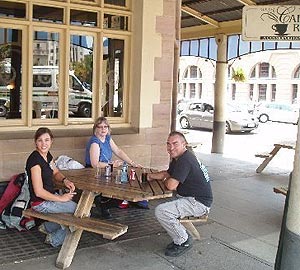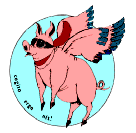|
“You go down there and win me a trip,” she said as I was leaving. Brenda had been perusing the BMWMOA brochure for all the various tour companies that would be present at the National Rally in June, ’09. I was packed up on the ’93 PD and ready to head out to meet my nephew Paul for a quick weekend run to Johnson City. After our once-in-a-lifetime trip that previous March to New Zealand, Brenda and I had joked that the only way we’d get another overseas bike trip was to win it. The joke was predicated on the fact that I never win anything. If there were two tickets in a box, mine would stay put. Brenda, on the other hand, often gets door prizes at events, and once even won a four-day trip to the Bahamas by dropping a card in a box at Barney Miller’s while I was paying for a VCR.
At the Rally, I did all the usual rally stuff, walking down the rows of vendors, marveling at the gimcracks and gadgets, farkles and sparkles that can be had. I finally made my way to the row where the tour operators had set up shop. I talked briefly to the ones selling tours to New Zealand and Germany and the Italian Alps. At one booth near the end, I had a pleasant conversation with Nicole, the young woman representing SAMA Tours (South African Motorcycle Adventures) in South Africa. She told me that it wasn’t like the media portrayed Africa to be, showed me photos of the lovely mountain vistas and the obligatory pictures of the lions and elephants. I dropped a card in the box, as I had done with all the others, picked up a brochure and went on to look at more Bike Stuff, never giving it a second thought.
It was a good rally and a wonderful ride to and from (including the encounter with the bear on the Little Shepherd Trail on the way back) and soon I had to return to the real world of making a living. About two weeks after the rally, I was at lunch with friends at the little café next to my office. My cell phone rang, and when I checked the number on the screen, I didn’t recognize the area code. I answered the call and was told by a vaguely familiar female voice with a South African accent, “Congratulations! You’ve won the ten-day motorcycle/train tour from SAMA.” I thanked her politely and hung up. It took me several minutes for the realization to sink in that the call had been genuine. I called Brenda to tell her the news. Her squeal at the other end of the phone gave me to believe that perhaps she was interested in going.
The prize included the ten-day tour, use of an R1200GS, all rooms, the train fare across the Karoo Desert, and many of the meals. What it didn’t include was the air travel to get there and back or the pillion fee for bringing a passenger. Those two items came to about the same as the cost of the tour itself. Nonetheless, we were in for the whole shebang. I picked a date in February because 1) it was the nearest date, and 2) I’ll do almost anything to get out of Kentucky in February—which is, contrary to popular belief, the longest month of the year.
As the date drew near, we prepared by reading tour books (most of which told us how not to get killed while we were there) and in the interest of research, going to see the movie “Invictus,” which dealt with Nelson Mandela’s efforts to reunite the country after the end of apartheid by, among other things, promoting the primarily white national rugby team. I watched “The Long Way Down,” the chronicle of a trip by three guys on R1200GS’s down through Africa....with a full support crew and a six-million-dollar budget. We would be traveling in a more luxurious style than we had ever done before, we thought, but still a bit short of that level. We'd never done an organized, professional tour before, so we didn't really know what to expect.
It was a long flight, seventeen hours, but the last few hours were the best. From the back of the plane, I watched the sun slowly illuminate the African coastline, then the Namibian desert as we flew over the sand dunes. The sand gave way to mountains, then roads and finally villages as we crossed over Botswana and into South Africa, finally to the urban sprawl of Johannesburg.
We were met at the airport by Jonathan Berman from SAMA, who whisked us away to Pretoria and ensconced us in our B&B for the night. The lovely Marloot House is situated on a hillside, the architecture making it appear more as though it has grown there than been built. Our hosts made us comfortable immediately, and after a quick supper, we fell in bed for the first time in about thirty-two hours.
On February 8th, Monday, promptly at 9:00 a.m., the tour operators came to pick us up at the B & B and take us to their facility (also their house), which is less than half a mile away. We learned that for this first five days of the tour, until we returned to Pretoria to embark on the train portion, we would be the only participants on the trip, just Brenda and I with the guide. Not very profitable for the operator, but true to his word, he was going to give us the full experience. I went through the process of getting the paperwork done and did the necessary walk-around of the blue R1200GS before we could take off on our half-day tour of the city of Pretoria. Darryl, the owner of the company, and his assistant Tamzin rode an orange GS just ahead of us. Riding on the left side of the road in a big city was interesting enough; but here in Pretoria they have a particular hazard, minivans used as taxis, whose operators drive much like taxi drivers everywhere would do if they weren’t constrained by pesky traffic laws. They toot their horns (or hoot, as the locals call it) constantly as they drive, to alert passersby that they are available for passengers; if a potential customer is spotted, the minivan goes to that location, whether or not there is a car or motorcycle in the way. If it requires making a U-turn across several lanes of traffic, so much the better. The roads here are all under construction, in preparation for the World Cup Soccer Games to be held this summer. Apparently they were supposed to have the highways completed before that event, but like all highway departments, they are a bit behind schedule.
Darryl and Tamzin led us down through a maze of such traffic and finally up into the hills above Pretoria. We stopped at an overlook that gave a view of the entire bowl in which Pretoria sits rimmed by the mountain range that forms the opposite side.
 |
Two American motorcyclists who still can't believe they're in Africa |
This range, according to Tamzin, who is taking a college degree in adventure touring, is the Magaliesberg, one the longest and oldest ranges (about a hundred times older than Everest) in Africa. From the top of this overlook we could see the ranges where the rugby tournament was played in the movie Invictus, and could clearly see how the jumbo jet swooped down over the stadium to display its fan message during the game. Darryl told us that in the proper season the Jacaranda trees all bloom purple at once, making the entire valley look like a purple haze. (Do you suppose that Jimmy Hendrix had visited here?)
Down from the overlook we went into the bowl and weaved our way through the downtown traffic of Pretoria to Church Square for lunch at the Café Riche on an outdoor table overlooking the square.
| The intern's job at my office is doing research and drafting documents. This is Tamzin's job. |
 |
We explored the square, wandering around among the market stalls surrounding the statue, and then followed Tamzin into an old theater (now used as a parking garage!) that harkened back to the elegance and opulence of Pretoria’s past. All the street signs here are in English, as are the vast majority of the advertising signs one sees on the road or in the shop windows. On the streets you hear mostly English but also a heavy dose of Afrikaans being spoken. There are apparently eleven official languages here, but English is sort of the universal default used more or less effectively by everyone. Darryl told us that during apartheid, which only ended in the late ’90s, there were mainly white citizens on the streets of Pretoria, but now the ethnic mix in the crowds more accurately mirrors the true population, about ninety percent nonwhite.
This square marks the spot where the Voortrekkers, South Africa’s version of our western settlers, first settled when they came into the area in the 1800s. There was a church built there as their first edifice and then the square was built around it. As it developed, the square was designed by an architect who modeled it after Trafalgar Square in London, England, with the statue of Lord Nelson replaced by one of Paul Kruger, a hero of the Boer Wars and the first President of South Africa.
 |
Tamzin and Brenda get the
Voortrekker history
lesson from Darryl |

Voortrekker ponders why he shaved off the moustache but left the beard
From Church Square we got back on the bikes and went through the city up to the Voortrekker Monument. On our way into the monument, which is arranged like a huge park, we were amazed to see herds of zebra and wildebeest grazing on the grounds. At first it seems unbelievable, and then the realization sinks home that despite being in this modern city, we really are in Africa.
| More history from Darryl, as we ponder climbing those steps in riding gear |
 |
The Monument is an enormous granite structure shaped a lot like our old iron furnaces but twenty times the size, built on top of a hill in such a way that on December 16th of each year, the anniversary of the Battle of Blood River, the sun shines through a small hole in the roof down through the building to a cenotaph at the bottom that celebrates the unity of the Voortrekkers. The Battle of Blood River (so named because the “river ran red with blood” from casualties) was the decisive battle in which the mostly Dutch settlers repelled the natives and established their hold on this part of the territory. Inside the monument is a plaster relief sculpture that goes around all four walls, encapsulating the major events of the long journey to this settlement.

Darryl, who isn't this blurry in real life, narrates the story for Brenda
The artwork portrays their version of the hardships and their battles against the natives they encountered. As in our Indian wars, the settlers were armed with rifles and moving into areas already occupied for generations by natives whose weapons were hand-carried spears. It is another example of the adage that the winners get to write the history. To Rice page 2
|






